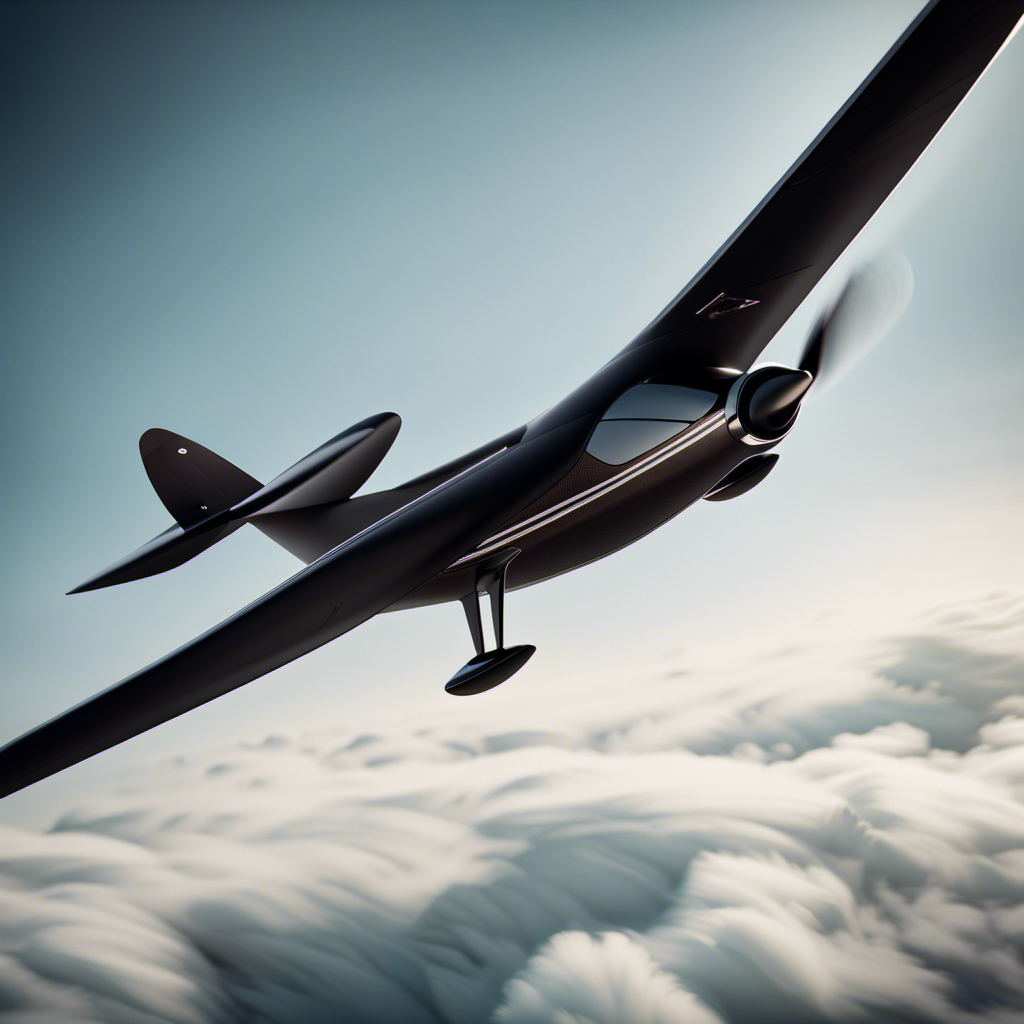Did you know that the materials chosen for constructing a glider can greatly affect its performance and durability?
In this article, I will delve into the fascinating world of glider plane materials. From the wing materials that provide lift to the fuselage materials that house the passengers, we will explore the various components that make up these soaring machines.
Join me as we uncover the secrets behind the construction of these incredible aircraft.
Key Takeaways
- Glider planes are made of various materials depending on the components, with aluminum, carbon fiber, and fiberglass being commonly used for wings.
- Aluminum is lightweight, easy to fabricate, and provides a good strength-to-weight ratio for optimal aerodynamics.
- Carbon fiber offers even greater strength and lighter weight, reducing fuel consumption and increasing payload capacity.
- Fiberglass is lightweight, strong, and cost-effective compared to carbon fiber, making it a popular choice for wing material.
The Basic Structure of a Glider Plane
To understand the basic structure of a glider plane, you’ll want to know what materials it’s made of. The design of the wings is crucial for the aerodynamics of the glider. The wings are typically constructed using lightweight materials such as carbon fiber or fiberglass composites. These materials provide the necessary strength and durability while keeping the weight of the glider to a minimum.
The wing design of a glider plane is essential for achieving maximum lift and minimizing drag. The wings are usually long and slender, allowing for greater lift and reduced drag. They are also designed with a high aspect ratio, which means the wings are long and narrow. This design helps to increase the efficiency of the glider by reducing induced drag.
Additionally, the wings of a glider plane may incorporate various aerodynamic features, such as winglets or flaps. Winglets are small, vertical extensions at the wingtips that reduce drag and improve stability. Flaps, on the other hand, are movable surfaces on the trailing edge of the wings that can be deployed to increase lift and control the glider’s speed.
Understanding the basic structure and wing design of a glider plane is crucial in comprehending its overall functionality and performance. Now, let’s delve into the specific materials used in constructing the wings of a glider plane.
Wing Materials
When it comes to the materials used in the construction of glider plane wings, three key options stand out: Aluminum, Carbon Fiber, and Fiberglass.
Aluminum is a popular choice due to its lightweight properties and ease of fabrication.
Carbon Fiber, on the other hand, offers exceptional strength-to-weight ratio, making it ideal for high-performance gliders.
Fiberglass is known for its durability and affordability, making it a common choice for recreational gliders.
Aluminum
You can easily identify a glider plane by its lightweight aluminum construction. The choice of materials for wing construction is crucial to achieve optimal aerodynamic design. Aluminum is favored for its strength-to-weight ratio, making it an ideal choice for glider wings. Its low density allows for the creation of large, yet lightweight wings that offer excellent maneuverability and efficiency in flight.
The aluminum wing construction also provides the necessary rigidity and stability required for gliding through the air. However, advancements in technology have led to the development of alternative materials, such as carbon fiber, which offer even greater strength and lighter weight. Transitioning to carbon fiber allows for enhanced performance and improved efficiency, making it an exciting prospect for the future of glider plane construction.
Carbon Fiber
Carbon fiber is known for its exceptional strength-to-weight ratio, making it a popular choice for various applications in aerospace engineering. Here are four advantages of carbon fiber in aircraft manufacturing:
-
Weight reduction: Carbon fiber is significantly lighter than traditional materials like aluminum, resulting in improved fuel efficiency and increased payload capacity.
-
High strength: Despite its lightweight nature, carbon fiber possesses incredible strength, making it capable of withstanding high stress and pressure encountered during flight.
-
Corrosion resistance: Unlike metals, carbon fiber is highly resistant to corrosion, reducing the need for frequent maintenance and enhancing the longevity of the aircraft.
-
Design flexibility: Carbon fiber composites can be molded into complex shapes, allowing for streamlined aerodynamic designs that minimize drag and enhance performance.
Transitioning to the subsequent section about ‘fiberglass,’ another popular material used in aircraft manufacturing…
Fiberglass
Fiberglass is known for being a lightweight and strong alternative in aircraft manufacturing, providing durability and fuel efficiency. When it comes to glider plane manufacturing, fiberglass offers several advantages.
Firstly, its lightweight nature allows for better gliding performance, as it reduces the overall weight of the aircraft. This results in improved soaring capabilities and increased maneuverability.
Secondly, fiberglass is highly resistant to corrosion, which is crucial in glider planes exposed to harsh weather conditions during flight.
Additionally, fiberglass is easy to mold into complex shapes, allowing for the creation of streamlined and aerodynamic designs.
Lastly, fiberglass is cost-effective compared to other materials like carbon fiber, making it a popular choice in glider plane manufacturing.
Transitioning to the subsequent section on fuselage materials, another important aspect of aircraft construction is the selection of suitable materials for the fuselage.
Fuselage Materials
When it comes to the materials used in aircraft fuselages, there are three key options to consider: aluminum alloy, composite materials, and titanium alloy.
Aluminum alloy is a popular choice due to its lightweight and corrosion-resistant properties, making it suitable for commercial aircraft.
Composite materials, on the other hand, offer a high strength-to-weight ratio and can be molded into complex shapes, making them ideal for advanced military aircraft.
Lastly, titanium alloy is known for its exceptional strength, heat resistance, and durability, making it a top choice for aerospace applications where strength and reliability are paramount.
Aluminum Alloy
Aluminum alloy is commonly used in the construction of glider planes. It offers several advantages in the glider plane manufacturing process:
-
Lightweight: Aluminum alloy is known for its low density, making it ideal for glider planes as it helps reduce weight and improve maneuverability.
-
Strength: Despite being lightweight, aluminum alloy exhibits exceptional strength and durability, ensuring the structural integrity of the glider plane during flight.
-
Corrosion resistance: Aluminum alloy has excellent resistance to corrosion, which is crucial in the demanding outdoor environment that glider planes operate in.
These properties make aluminum alloy an excellent choice for glider planes, as it allows for efficient and safe flight.
However, while aluminum alloy has its benefits, it is important to consider other materials like composite materials for specific parts of the glider plane, which we will explore in the next section.
Composite Materials
One advantage of using composite materials in aircraft construction is their ability to combine the strength of different materials. Composite materials are made up of two or more different materials, typically a matrix material and reinforcing fibers.
The manufacturing process for composite materials involves several steps. First, the matrix material, such as epoxy resin, is mixed with a hardener and applied to the reinforcing fibers, which can be made of carbon or glass. Then, the fibers are layered or woven together to form a strong and lightweight structure. The entire assembly is then cured under heat and pressure to bond the materials together.
This manufacturing process allows for precise control over the orientation and distribution of the reinforcing fibers, resulting in a material that is highly resistant to fatigue and corrosion.
However, titanium alloy offers its own unique advantages in aircraft construction.
Titanium Alloy
You can benefit from using titanium alloy in aircraft construction due to its exceptional strength and lightweight properties. Titanium is one of the strongest materials available, making it ideal for applications where durability is crucial. Its high strength-to-weight ratio allows for the creation of sturdy structures without adding unnecessary weight.
Here are five advantages of using titanium in aircraft construction:
- Increased fuel efficiency due to reduced weight
- Improved performance and maneuverability
- Enhanced resistance to corrosion and fatigue
- Increased lifespan of the aircraft
- Reduced maintenance and repair costs
Now, let’s move on to the next section and discuss the materials used in the tail section of a glider plane.
Tail Section Materials
In the discussion on tail section materials, I will explore the use of aluminum, composite materials, and steel.
Aluminum is a lightweight and corrosion-resistant material commonly used in aircraft construction, known for its strength-to-weight ratio.
Composite materials, such as carbon fiber reinforced polymers, offer high strength and stiffness while being lighter than aluminum.
Steel, on the other hand, provides excellent strength and durability, making it suitable for certain structural components in the tail section.
Aluminum
The wings of a glider plane are typically made of aluminum. Aluminum is a widely used material in glider plane manufacturing due to its lightweight nature and high strength-to-weight ratio. It provides the necessary structural integrity while keeping the overall weight of the aircraft low, allowing for better performance and longer flight durations.
However, in the quest for continuous improvement and exploration of alternative materials, manufacturers have been researching and experimenting with various composite materials. These materials offer the potential for even lighter and stronger wings, enhancing the glider plane’s aerodynamic efficiency and maneuverability.
These advancements have paved the way for a new generation of glider planes with enhanced performance capabilities.
Composite Materials
After discussing the use of aluminum in glider planes, let’s now turn our attention to another important material in aircraft construction: composite materials.
Composite materials are made by combining different types of materials, such as fibers and resins, to create a strong and lightweight material. Here are three advantages of using composite materials in glider plane construction:
-
Weight reduction: Composite materials are significantly lighter than traditional materials like aluminum, resulting in improved fuel efficiency and increased range.
-
Strength and durability: Composite materials have excellent strength-to-weight ratios, providing a high level of structural integrity and resistance to fatigue and corrosion.
-
Design flexibility: With composite materials, designers have the freedom to create complex shapes and structures, optimizing aerodynamics and enhancing performance.
However, it is important to consider the disadvantages of composite materials as well:
-
Higher cost: Composite materials can be more expensive to manufacture and repair compared to traditional materials.
-
Limited repairability: Unlike metals, composite materials can be more difficult to repair in the event of damage.
-
Susceptibility to impact damage: Composite materials can be more vulnerable to impact damage, which may require careful inspection and maintenance.
Transitioning to the subsequent section about ‘steel,’ we will explore its role in glider plane construction.
Steel
Now, let’s delve into how you can benefit from using steel in constructing glider planes. Steel is a popular choice due to its strength, durability, and cost-effectiveness. Compared to aluminum, steel offers greater structural integrity, making it ideal for withstanding the forces experienced during flight. In addition, steel has a higher resistance to fatigue, ensuring a longer lifespan for the glider plane. To better understand the advantages of steel, let’s compare it to aluminum in the table below:
| Property | Steel | Aluminum |
|---|---|---|
| Strength | High | Moderate |
| Durability | Excellent | Good |
| Cost-effectiveness | Affordable | Expensive |
Control Surfaces
To control the movement of a glider plane, you’ll use the control surfaces. These surfaces are specifically designed to manipulate the aerodynamic performance of the glider, allowing the pilot to maneuver through the air with precision. Here are three key components of control surface design:
-
Ailerons: These are located on the trailing edge of the wings and work in pairs. By moving one aileron up and the other down, the pilot can control the roll of the glider. This allows for banking and turning.
-
Elevator: Positioned on the horizontal stabilizer, the elevator controls the pitch of the glider. Moving it up or down changes the angle of the glider’s nose, influencing the climb or descent.
-
Rudder: Located on the vertical stabilizer, the rudder controls the yaw of the glider. By deflecting the rudder left or right, the pilot can maintain directional control during turns.
These control surfaces play a crucial role in the performance and maneuverability of a glider plane.
Now, let’s transition to the next section, where we will explore the materials used in the construction of the cockpit.
Cockpit Materials
The cockpit of a glider is typically constructed using lightweight materials to ensure optimal performance. Cockpit design and ergonomic considerations are crucial in creating a safe and comfortable space for the pilot. The materials used in the construction of the cockpit must be strong enough to withstand the forces experienced during flight, yet light enough to minimize the overall weight of the glider. Common materials used include carbon fiber, fiberglass, and aluminum alloys.
Carbon fiber is often favored for its high strength-to-weight ratio. It is lightweight and provides excellent structural integrity, making it an ideal choice for cockpit construction. Fiberglass is another commonly used material due to its durability and flexibility. It can withstand impacts and vibrations, ensuring the pilot’s safety. Aluminum alloys are also utilized for their strength and lightweight properties.
When designing the cockpit, ergonomic considerations are taken into account to optimize the pilot’s comfort and functionality. Factors such as seating position, reachability of controls, and visibility are carefully evaluated. The layout of instruments and controls are strategically positioned to ensure ease of use and minimize pilot workload.
As we transition into the subsequent section about support structures, it is important to note that these structures play a vital role in supporting the cockpit and distributing the load throughout the glider.
Support Structures
When it comes to the support structures of a glider plane, there are three key components to consider: struts and wires, landing gear, and wing attachments.
Struts and wires provide stability and support to the wings, helping to distribute the forces experienced during flight.
The landing gear allows for safe takeoffs and landings.
Wing attachments ensure a secure connection between the wings and the fuselage.
Struts and Wires
Glider planes use struts and wires to enhance their structure and stability. The design of the struts plays a crucial role in distributing the loads on the aircraft. These vertical supports are typically made of lightweight materials such as aluminum or carbon fiber composites. The struts are strategically positioned to provide strength and rigidity to the wings and fuselage, ensuring the structural integrity of the glider.
On the other hand, wire tensioning is essential for maintaining the shape and stability of the wings. The wires, often made of stainless steel or other high-tensile materials, are carefully adjusted to achieve the desired level of tension. This allows for better control and maneuverability during flight.
Moving on to the next section about landing gear, we will explore the mechanisms that enable glider planes to safely touch down.
Landing Gear
To safely touch down, you’ll need to understand how the landing gear on a glider functions. The landing gear design plays a crucial role in ensuring a smooth and controlled landing. It consists of three main components: the main wheel, tail wheel, and shock absorbers.
The main wheel is typically located under the fuselage and is responsible for bearing the weight of the glider during landing. The tail wheel provides stability and helps prevent nose-overs.
Regular landing gear maintenance is essential to keep these components in optimal condition. This includes inspecting for any signs of wear or damage, lubricating moving parts, and ensuring proper tire inflation. By maintaining the landing gear, you can ensure a safe and successful landing.
Speaking of important components, let’s now move on to discussing the wing attachments.
Wing Attachments
The wing attachments connect the wings to the fuselage and are crucial for the stability and maneuverability of the aircraft. These components play a vital role in ensuring that the wings remain securely attached to the fuselage during flight, enabling the aircraft to maintain its desired flight characteristics.
The design of the wing attachments is carefully engineered to optimize aerodynamic efficiency, reducing drag and enhancing the overall performance of the aircraft. Wing attachments are typically made of high-strength materials such as aluminum or titanium, ensuring durability and structural integrity.
They are designed to distribute the load evenly across the wings, preventing stress concentration and potential failure. The attachment points are strategically positioned to optimize weight distribution and maintain the desired center of gravity.
With the wing attachments securely in place, the aircraft is ready for the next step in its construction: the installation of interior components.
Interior Components
When it comes to the interior components of a glider plane, there are several key points to consider.
The seats in a glider are designed to provide comfort and support during long flights, with adjustable features to accommodate different pilots.
The instrument panel houses essential gauges and controls for navigation and monitoring, including altimeters, airspeed indicators, and variometers.
Lastly, safety equipment such as seat belts, emergency parachutes, and fire extinguishers are crucial to ensure the well-being of the pilot and passengers in case of emergencies.
Seats
Seats in a glider plane are typically made of lightweight materials to ensure maximum comfort and safety for the pilot and passengers. Glider seat design is focused on minimizing weight while providing adequate support and cushioning.
The most commonly used materials for glider seats are carbon fiber and fiberglass. These materials offer a high strength-to-weight ratio, making them ideal for aviation applications. The seats are ergonomically designed to provide proper lumbar support and are often equipped with adjustable features to accommodate different body types.
The use of lightweight materials not only enhances the overall performance of the glider but also reduces the strain on the structure, allowing for longer flights and increased maneuverability.
Moving from the seats to the instrument panel, it is essential to have a well-designed layout for efficient operation of the aircraft.
Instrument Panel
As you take a closer look at the instrument panel, you’ll notice a variety of gauges and controls that allow the pilot to monitor and operate the aircraft.
The instrument panel is an essential component of the cockpit, providing crucial information about the aircraft’s performance and status.
The materials used in instrument panel construction are carefully chosen to ensure durability and functionality. Typically, instrument panels are made from lightweight and sturdy materials such as aluminum or composite materials like carbon fiber. These materials offer high strength-to-weight ratios, making them ideal for aviation applications.
In terms of design, instrument panels are carefully laid out to optimize visibility and accessibility for the pilot. The placement of gauges and controls is strategically arranged to minimize distractions and facilitate efficient operation.
With a well-designed and durable instrument panel, pilots can confidently fly the aircraft while maintaining complete control.
Moving on to safety equipment, it is crucial for pilots to have the necessary tools and gear to ensure a safe flight.
Safety Equipment
The pilot should always have a functioning fire extinguisher on board for safety purposes. In addition to a fire extinguisher, there are other essential safety equipment items that every pilot should have in their glider plane:
-
Parachute Systems: Parachutes are crucial for emergency situations where the pilot needs to eject from the glider. These systems are designed to deploy quickly and safely, ensuring the pilot’s survival.
-
Emergency Beacons: These devices can be activated to send distress signals, allowing search and rescue teams to locate the glider in case of an emergency or crash landing.
-
First Aid Kit: Having a well-stocked first aid kit is essential in case of injuries during flight. It should include basic medical supplies for treating minor injuries until help arrives.
-
Emergency Rations: It’s important to have enough food and water to sustain oneself in case of an unforeseen emergency or landing in a remote location.
Ensuring that all these safety equipment items are present and in good working condition is crucial for the pilot’s safety and survival.
Moving on to the next topic, let us now discuss the importance of surface coatings on a glider plane.
Surface Coatings
One of the key elements in glider plane construction is the use of specialized surface coatings to enhance its performance. These coatings serve multiple purposes, from improving aerodynamics to protecting the aircraft from corrosion. The table below provides an overview of the different surface coatings commonly used in glider plane construction:
| Surface Coating | Purpose |
|---|---|
| Polyurethane | Provides a smooth and glossy finish |
| Epoxy | Enhances strength and durability |
| Anti-corrosion | Prevents corrosion and rusting |
| Thermal insulation | Regulates temperature inside the aircraft |
| Anti-icing | Prevents ice formation on critical surfaces |
Surface coatings play a crucial role in preventing corrosion on glider planes. As these aircraft often operate in harsh environments and are exposed to moisture and varying weather conditions, corrosion prevention is essential for their longevity and safety. The anti-corrosion coatings create a protective barrier on the aircraft’s surface, shielding it from corrosive agents such as saltwater, pollutants, and oxidation. Regular inspections and maintenance are necessary to ensure the coatings remain intact and effective in preventing corrosion.
Moving on to maintenance and repair, it is vital to address any issues promptly to maintain the integrity of the surface coatings and ensure the continued performance of the glider plane.
Maintenance and Repair
Regular inspections and prompt repairs are essential for maintaining the integrity and performance of the surface coatings on a glider. As a glider pilot, I understand the importance of following a maintenance schedule to ensure the safety and longevity of my aircraft.
The maintenance schedule includes regular visual inspections of the surface coatings to check for any signs of damage or wear. Common repairs that may be needed include patching up small areas of peeling or chipped paint, fixing any cracks or dents, and addressing corrosion issues. It is crucial to address these repairs promptly to prevent further damage and to maintain the aerodynamic efficiency of the glider.
Additionally, regular cleaning and washing of the surface coatings help to prevent dirt and debris from accumulating and potentially causing damage. By adhering to a maintenance schedule and promptly addressing common repairs, I can ensure that my glider remains in optimal condition, providing me with a safe and enjoyable flying experience.
Frequently Asked Questions
How much does a glider plane typically weigh?
A glider plane typically weighs between 300 to 600 kilograms. The weight may vary depending on its size, design, and construction materials. The construction materials used in glider planes are typically lightweight, such as carbon fiber or fiberglass.
What are the advantages of using composite materials in the construction of a glider plane?
Using composite materials in the construction of a glider plane offers several advantages. These include lighter weight, increased strength, improved aerodynamics, and better fuel efficiency.
Are there any regulations or standards that govern the materials used in glider plane construction?
Yes, there are regulations and standards that govern the materials used in glider plane construction. These guidelines ensure safety, performance, and structural integrity of the aircraft, and cover areas such as strength, weight, and fire resistance.
Can glider planes be made from recycled or sustainable materials?
Glider planes can be made from recycled or sustainable materials, offering recycling options and reducing their environmental impact. By using such materials, we can promote sustainability in aviation and minimize waste in the industry.
Are there any specific considerations regarding the materials used for glider planes in extreme weather conditions?
In extreme weather conditions, specific considerations must be made regarding the material durability and extreme weather performance of glider planes. These factors ensure the aircraft’s ability to withstand harsh conditions and maintain safe flight operations.
Conclusion
In conclusion, glider planes are meticulously crafted using a variety of specialized materials. From the composite wings made of lightweight carbon fiber to the aluminum fuselage that provides strength and durability, each component is carefully chosen to ensure optimal performance.
The tail section is typically constructed using a combination of materials such as fiberglass and carbon fiber. Control surfaces, support structures, and interior components are also designed with precision and efficiency in mind.
With proper maintenance and repair, these remarkable aircraft can soar through the skies with grace and ease. But have you ever wondered what it feels like to glide through the clouds, weightless and free?
With a heart that soars as high as the skies, Aria, affectionately known as “Skylark,” is the driving force behind Soaring Skyways. Her journey into the gliding world began as a young dreamer gazing up at the soaring birds, yearning to experience the weightlessness and freedom they embodied. With years of experience both in the cockpit and behind the scenes, Aria’s commitment to the gliding community is unwavering.










